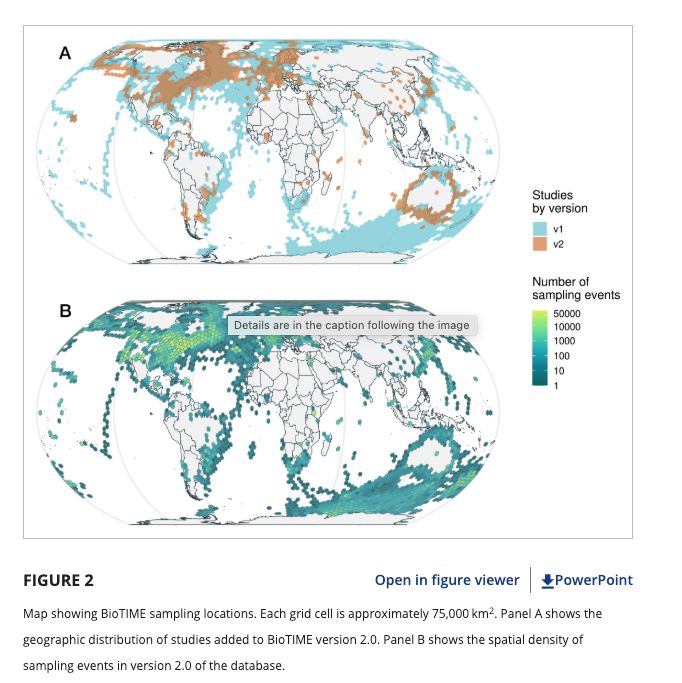
..aside from the inherent interest in species ranges which naturalists of all shapes interact with daily (and that we have so much still to learn about!)

..aside from the inherent interest in species ranges which naturalists of all shapes interact with daily (and that we have so much still to learn about!)
Understanding elevational ranges, allows us to understand elevational changes..
We know that tropical montane birds are shifting their ranges upslope.. (e.g. www.pnas.org/doi/abs/10.1...)

Understanding elevational ranges, allows us to understand elevational changes..
We know that tropical montane birds are shifting their ranges upslope.. (e.g. www.pnas.org/doi/abs/10.1...)
lower elevation (dominant) Catharus mexicanus, preferentially chooses open broadleaf forest and avoids fern dominated forest, excluding the higher elevation (subordinate) C.frantzii to habitats it doesn't want to occupy..


lower elevation (dominant) Catharus mexicanus, preferentially chooses open broadleaf forest and avoids fern dominated forest, excluding the higher elevation (subordinate) C.frantzii to habitats it doesn't want to occupy..
The interaction between them is asymmetric (the norm in birds) - with the lower elevation species, dominant over its higher elevation counterpart.
So WHY NOT go higher up, if you can?


The interaction between them is asymmetric (the norm in birds) - with the lower elevation species, dominant over its higher elevation counterpart.
So WHY NOT go higher up, if you can?
The upshot here is that thermal physiology has no bearing on where species CAN physically live (2x BMR suggested as the physiological 'ceiling' for species) - our species live comfortably within this.
So if not physiology, then what?


The upshot here is that thermal physiology has no bearing on where species CAN physically live (2x BMR suggested as the physiological 'ceiling' for species) - our species live comfortably within this.
So if not physiology, then what?
3. Measuring thermal physiology - what energetic cost to cold exposure does a species incur at different elevations?
4. Measuring microhabitat at every survey site
5. Experimentally testing how competition looks between species onlinelibrary.wiley.com/doi/full/10....


3. Measuring thermal physiology - what energetic cost to cold exposure does a species incur at different elevations?
4. Measuring microhabitat at every survey site
5. Experimentally testing how competition looks between species onlinelibrary.wiley.com/doi/full/10....
1. Establishing abundance patterns across elevation by lots of point counts
2. Characterising the thermal environment birds experience across elevation..


1. Establishing abundance patterns across elevation by lots of point counts
2. Characterising the thermal environment birds experience across elevation..
1. Physiology (its too cold/hot at different elevations for a species to persist)
2. Competition between species limits distribution
3. Habitat (an ecological preference/specialism limits the range)..
There is nice work on each, but nothing pulling them together...

1. Physiology (its too cold/hot at different elevations for a species to persist)
2. Competition between species limits distribution
3. Habitat (an ecological preference/specialism limits the range)..
There is nice work on each, but nothing pulling them together...
Higher up = common, lower down = absent (or vice versa)
But what causes this?!
and why do species occur where they do?!
our understanding of what limits species ranges is still remarkably incomplete..



Higher up = common, lower down = absent (or vice versa)
But what causes this?!
and why do species occur where they do?!
our understanding of what limits species ranges is still remarkably incomplete..
Also another wake up call as to the massive biological data gaps across equatorial Africa (and the tropics in general)..

Also another wake up call as to the massive biological data gaps across equatorial Africa (and the tropics in general)..



search.macaulaylibrary.org/catalog?tag=...


search.macaulaylibrary.org/catalog?tag=...
We don't actually know that the calls of the birds referred to here (in several other locations in the western Congo Basin), are Itombwe/Prigogine's Nightjar!
They are presumed, and a looot of questions remain, and it could indeed be an sp nov...
web.archive.org/web/20220302...

We don't actually know that the calls of the birds referred to here (in several other locations in the western Congo Basin), are Itombwe/Prigogine's Nightjar!
They are presumed, and a looot of questions remain, and it could indeed be an sp nov...
web.archive.org/web/20220302...
Stay tuned for much more from our programme!
Are you a bander and interested in joining in the field?
these data?
tropical montane birds?
contact me! 5/5
#ornithology @ibisjournal.bsky.social

Stay tuned for much more from our programme!
Are you a bander and interested in joining in the field?
these data?
tropical montane birds?
contact me! 5/5
#ornithology @ibisjournal.bsky.social
Such long term projects are essential in understanding fundamental ecology of tropical birds, as well as change..
e.g. this 10yr old Spotted Woodcreeper-left, and an immature (FCF) Slate-coloured Solitaire 4/5


Such long term projects are essential in understanding fundamental ecology of tropical birds, as well as change..
e.g. this 10yr old Spotted Woodcreeper-left, and an immature (FCF) Slate-coloured Solitaire 4/5
I wrote about this a long time ago in @btobirds.bsky.social
'Lifecycle' but now these data are finally seeing daylight! 3/5


I wrote about this a long time ago in @btobirds.bsky.social
'Lifecycle' but now these data are finally seeing daylight! 3/5

